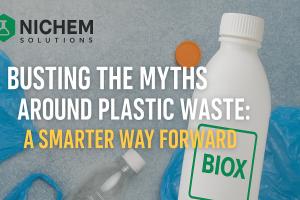Busting the Myths Around Plastic Waste: A Smarter Way Forward
Revolutionary BioX additive breaks down polyolefin within 2 years, enabling faster, eco-friendly degradation of plastics without forming microplastics!
Nichem Solutions, we believe innovation like BIOX is key to turning waste into opportunity.”
INDIA, August 23, 2025 /EINPresswire.com/ -- On World Environment Day, observed each June 5 with the theme “End Plastic Pollution”, global attention once again turns to the challenge of plastic waste. From clogged urban drains to floating garbage patches in oceans, the issue is urgent. But is banning plastic the real solution?— Team Nichem Solutions
Plastic often becomes the villain of environmental narratives, but eliminating it may not deliver the solution we expect.
The bigger challenge lies in how we use, dispose of, and manage plastic, not in the material itself. Rather than condemning plastic outright, we need to look at smarter, more sustainable ways to handle it.
The Plastic Problem: Real or Framed?
Plastic pollution is real. It harms marine life, clutters landscapes, and can persist for decades. Yet plastic also revolutionized modern life from sterile medical packaging to safe food storage and efficient transportation.
The real issue is the “make, use, toss” culture and broken waste management systems, not plastic’s existence. Poor segregation, low recycling rates, and improper disposal have created the problem we see today. “Plastic isn’t evil. The way we use and dispose it off is.”
The Problem with Eco Alternatives
The global push to eliminate plastics has encouraged industries to turn to paper, cotton, jute, and bioplastics like PLA. While these appear “eco-friendly,” their hidden costs reveal that replacements are not always better.
Plastics, though persisting 100–500 years, require little to produce—0.1 acres of land and under 500 liters of water per ton. At USD 1,200 per ton, they are resource-efficient and affordable, with persistence the main drawback.
Paper degrades in two months but consumes 300,000 liters of water per ton and often drives deforestation. Though cheaper at USD 600 per ton, its ecological burden is heavy.
Cotton, biodegradable in six months, demands 3 acres and 22.5 million liters of water per ton. At USD 1,500, it is costly and unsustainable in water-scarce regions.
Jute requires 1.5 acres and 5 million liters of water per ton. It degrades in 1–2 years and costs USD 710, but large-scale use risks displacing food crops.
PLA (Polylactic Acid), marketed as green, uses 1.1 acres and 8 million liters per ton. It biodegrades only in industrial composting, persisting up to 80 years otherwise. At USD 3,000, it is the most expensive, often imported, raising carbon and financial costs.
Every material carries trade-offs. Plastics persist but demand far fewer resources. Alternatives consume enormous land, water, and energy. Blind bans risk shifting—not solving—the burden.
Busting the Myths: What We Often Get Wrong About Plastic
In the rush to “go green,” several assumptions dominate public discourse. But many of these are simplified narratives that can distract us from real progress.
Myth 1: All Plastics Are Bad
Not true. Plastics play life-saving roles, and not all are single-use or unmanageable.
Myth 2: Bans Fix Everything
Bans often push shifts to paper or cotton, causing more strain via resource-intensive alternatives.
Myth 3: Bioplastics Always Break Down
PLA decomposes only in industrial composting, not landfills or oceans. In India it is imported, expensive, and less viable. A “bioplastic” label doesn’t guarantee sustainability.
Myth 4: It’s Too Late to Fix the Plastic Problem
Solutions exist but often get overshadowed by dramatic bans or quick substitutions. Science-driven approaches can reduce waste drastically.
Why Plastic Does Not Degrade Easily?
Most plastics are derived from petroleum, a product of ancient organic matter. Their resistance lies in chemical structure: simple monomers linked by strong carbon-carbon bonds uncommon in nature. Microorganisms decompose natural bonds, not synthetic ones, so plastics persist for decades or centuries. Some plastics degrade under industrial composting, yet still leave microplastics. Instead of blaming origin, we need technologies that make plastics recognizable to nature.
Meet BioX: Why to Replace When We Can Degrade?
NICHEM Solutions, a leader in chemical technology and sustainable innovation, has taken a science-first approach to plastic waste. The aim is to clarify misunderstandings around plastic sustainability and offer practical solutions.
Their flagship innovation, BioX, is currently under the patent process. It is a biodegradable additive developed to break down conventional polyolefins like polyethylene and polypropylene. When blended during manufacturing, it allows plastic packaging, such as films, pouches, and bags, to degrade more efficiently without compromising functionality. Instead of replacing existing plastic materials, BioX helps convert them into a monomeric structure, which naturally occurring microorganisms can then process.
Features
● Works in both aerobic, anaerobic and marine environments
● Does not form microplastics post-degradation
● Does not need composting infrastructure or sunlight
● Minimises methane emission during degradation
● Retains properties and functionalities of plastic during use
● Safe for marine life, soil, and plant germination
Final Thoughts: Less Panic, More Progress
Ending plastic pollution does not mean you have to choose paper over plastic or swap one material for another. It is more about managing waste smarter with better habits, better systems, and better science.
Plastic, when mismanaged, is a problem. But when used wisely and paired with innovations like BioX, it can remain a valuable material for a sustainable future.
NICHEM invites everyone, from industries to educators, policymakers to citizens, to rethink their assumptions. Explore NICHEM’s Myth Buster blog series and learn how BioX is transforming plastic management.
Note: Values depicted are approximate based on internal research. They are subjected to change based on the updation of relevant data.
NICHEM Solutions
NICHEM Solutions
info@nichem.solutions
Visit us on social media:
LinkedIn
Facebook
X
Legal Disclaimer:
EIN Presswire provides this news content "as is" without warranty of any kind. We do not accept any responsibility or liability for the accuracy, content, images, videos, licenses, completeness, legality, or reliability of the information contained in this article. If you have any complaints or copyright issues related to this article, kindly contact the author above.

